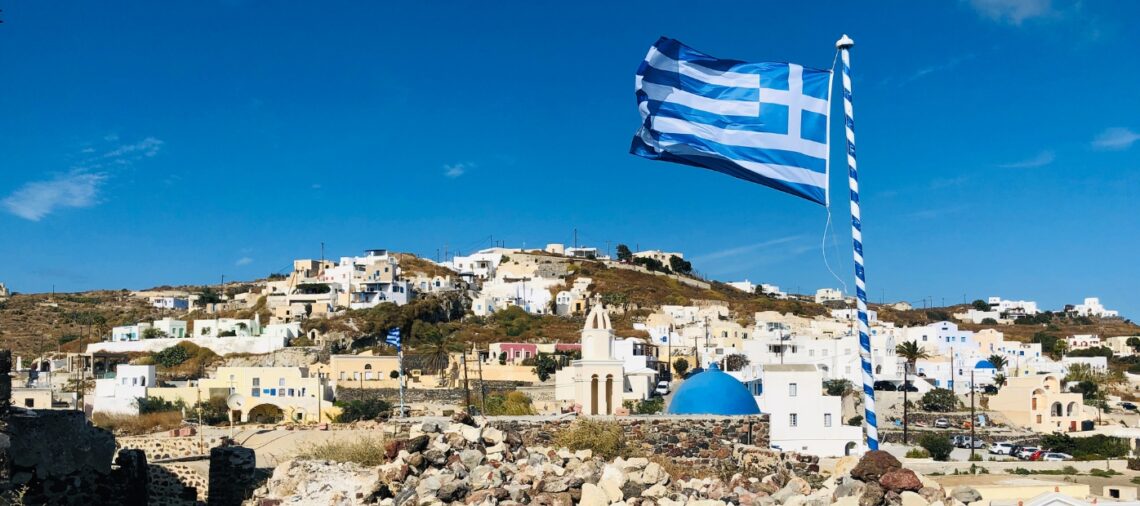Take a fascinating journey to Akrotiri, a historic archaeological site in Santorini, Greece. Delve into the secrets of this remarkably preserved ancient settlement from the Bronze Age, hidden beneath layers of volcanic ash for countless years. Roam through the remnants of an advanced civilization, with its walls adorned with intricate frescoes that quietly recount stories of a distant era. Explore the marvels of urban planning and uncover the valuable historical knowledge that Akrotiri holds. As you navigate the ruins of Santorini’s past, get ready to be transported to a vanished world eager to unveil its mysteries. Ready for exploring Akrotiri? Here we go!
History of Akrotiri
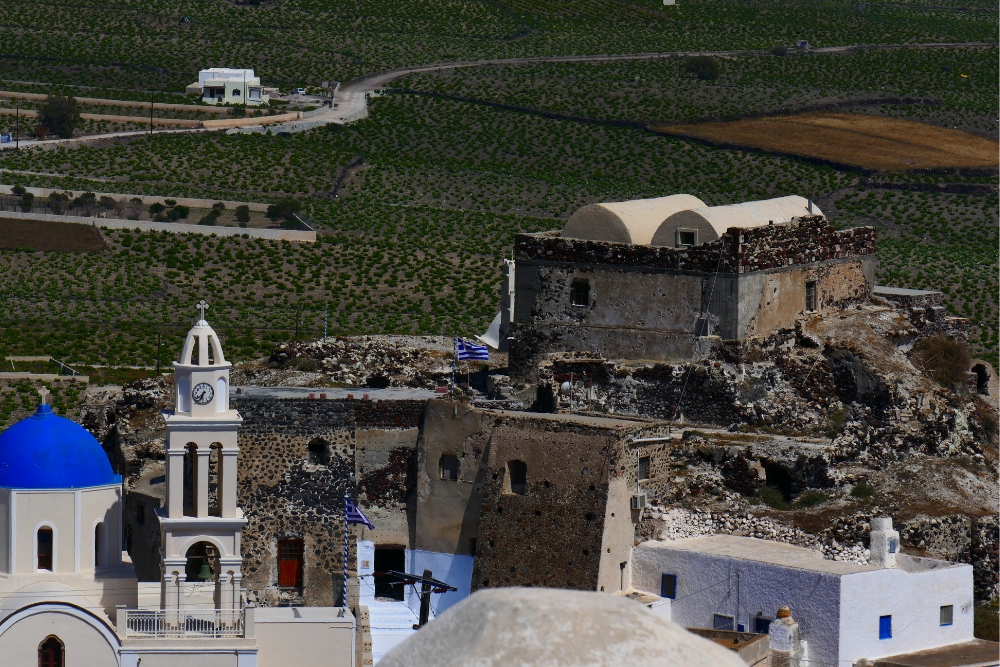
Uncover the fascinating history of Akrotiri, a Bronze Age settlement buried beneath volcanic ash on the island of Santorini, Greece. Akrotiri Santorini is often called the “Minoan Pompeii” due to its well-preserved state after being covered by the Theran eruption around 1600 BC. The history of Akrotiri dates back over 3,600 years, showcasing advanced urban planning, multi-story buildings, and intricate drainage systems.
Visiting Akrotiri in Santorini is worth it for history enthusiasts and those intrigued by ancient civilizations. The archaeological site offers a glimpse into the daily life and culture of the Minoans, shedding light on their artistic achievements, trade networks, and religious practices. Exploring the ruins of Akrotiri allows you to walk through streets, enter houses, and marvel at the frescoes that adorn the walls, providing a unique and immersive experience of the past.
The history of Akrotiri continues to captivate researchers and visitors alike, making it a must-visit destination for anyone seeking to unravel the mysteries of this ancient Bronze Age settlement.
Archaeological Discoveries
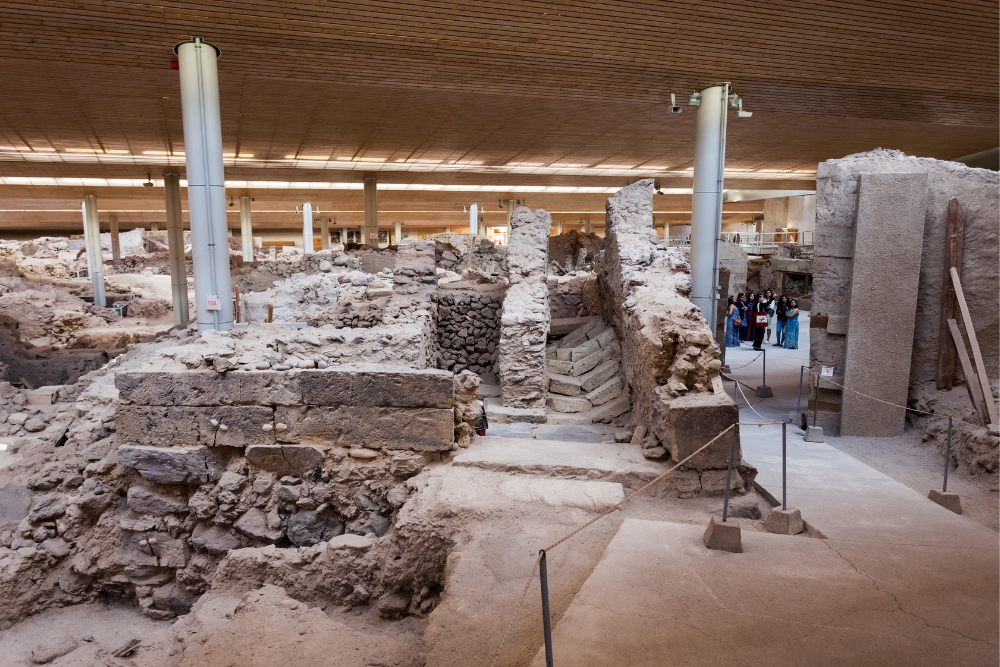
Numerous significant archaeological discoveries have shed light on the ancient civilization of Akrotiri, unveiling a wealth of historical insights buried beneath volcanic ash on Santorini island. The Akrotiri Santorini tour offers visitors a chance to witness the remarkably preserved remains of this Minoan Bronze Age settlement, often referred to as the “Minoan Pompeii.” Akrotiri is famous for its advanced urban planning, sophisticated multi-story buildings, intricate drainage systems, and vibrant frescoes depicting daily life and religious practices.
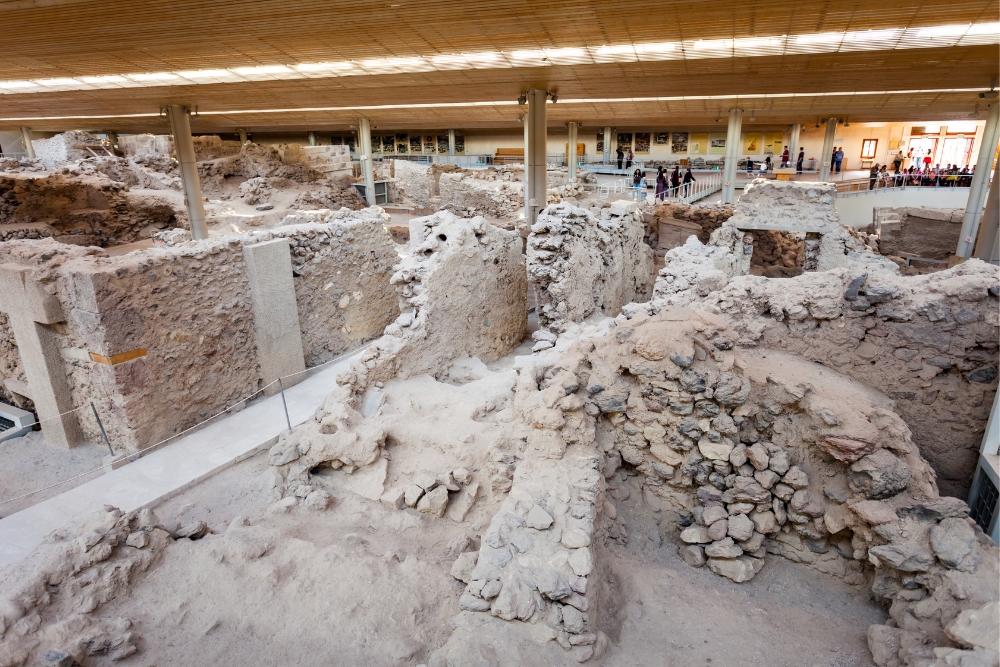
One of the intriguing aspects of Akrotiri is its age compared to Pompeii. While both are ancient archaeological sites frozen by catastrophic events, Akrotiri is believed to be older than Pompeii. The eruption of the Thera volcano around 1600 BCE buried Akrotiri under layers of ash, preserving the city in remarkable condition. This catastrophic event, although devastating, has provided archaeologists with a unique opportunity to study and understand the ancient Aegean civilization that thrived in Akrotiri.
Urban Planning Insights
Akrotiri’s ancient urban planning reveals a meticulously designed layout that showcases the sophistication and foresight of its Minoan inhabitants. The city was well-organized with multi-story buildings, complex drainage systems, and paved streets, indicating a high level of architectural and engineering knowledge for its time. While Akrotiri itself is an archaeological site and not a modern place to stay in Santorini, it offers a glimpse into the past and can be visited as part of a day trip.
However, if you are looking for accommodation, there are plenty of charming options in nearby towns like Fira or Oia, known for their stunning views of the Caldera. Akrotiri Santorini beach is a hidden gem with red sand and clear waters, perfect for a relaxing day by the sea. For those seeking more beach options, the famous Red Beach and White Beach are also near Akrotiri, offering unique landscapes and beautiful swimming spots.
Intricate Frescoes Unveiled
Step into the ancient world of Akrotiri and be captivated by the stunning intricacy of the recently unveiled frescoes adorning its walls. The Akrotiri frescoes are remarkable, depicting scenes of daily life, nature, and mythology with vibrant colors and exquisite detail. These ancient artworks provide a window into the past, offering insights into the culture and beliefs of the Minoan civilization that inhabited Santorini thousands of years ago.
When exploring Akrotiri, spend a decent amount of time admiring these breathtaking frescoes. Experts suggest spending at least a couple of hours wandering through the ruins to appreciate the beauty and significance of the artwork truly. The word “Akrotiri” itself has a Greek meaning; it translates to “promontory” or “cape,” which is fitting given the location of the ancient site on the southern tip of Santorini.
As you wander through the well-preserved buildings of Akrotiri, allow yourself to be transported back in time by the mesmerizing frescoes that adorn the walls, providing a glimpse into the ancient civilization that once thrived in this remarkable place.
Significance of Akrotiri
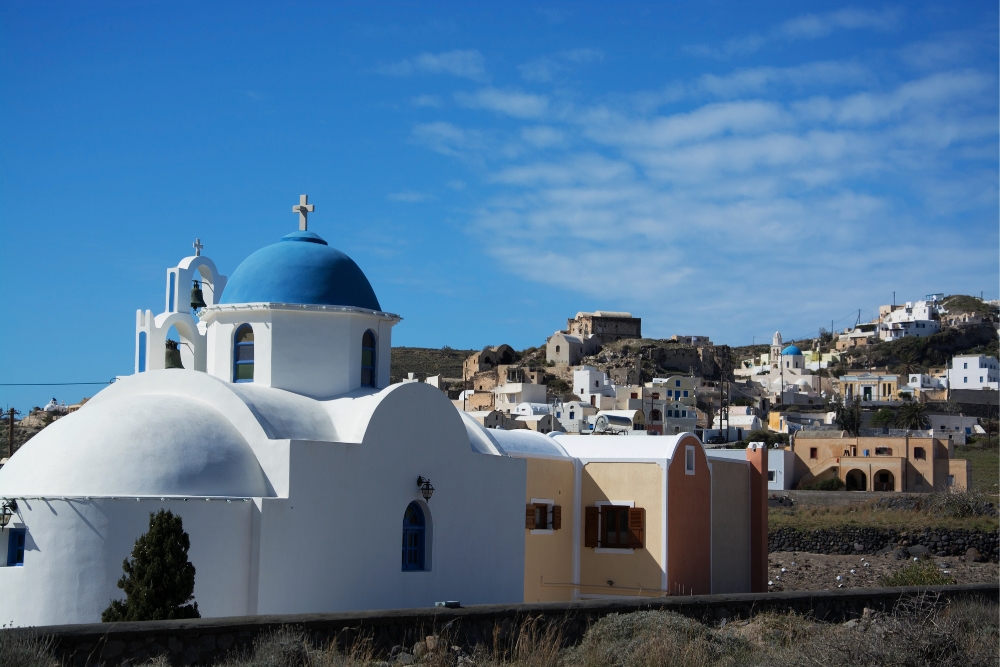
Explore the enigmatic allure of Akrotiri by uncovering its profound significance in illuminating the ancient history and culture of Santorini, Greece. Akrotiri, often called the “Minoan Pompeii,” offers a glimpse into the advanced civilization of the Bronze Age. To truly appreciate the site, consider spending at least half a day exploring its ruins and absorbing their rich history. The well-preserved structures, intricate frescoes, and advanced urban planning of Akrotiri provide valuable insights into the ancient Aegean world’s daily life, art, and architecture.
When planning your visit, consider dedicating around 2-3 hours to see the archaeological site. This timeframe allows you to wander the streets, marvel at the multi-story buildings, and admire the artifacts on display. Additionally, a guided tour can enhance your experience by providing detailed explanations of the site’s significance and historical context. Akrotiri’s archaeological wonders await those eager to delve into the mysteries of Santorini’s ancient past.
Exploring Santorini’s Ancient Past
Delve into the ancient past of Santorini by uncovering the intriguing stories and historical mysteries that lie beneath its captivating landscapes. Santorini’s ancient history is rich and diverse, with evidence of human activity dating back thousands of years. The island’s volcanic eruptions have played a significant role in shaping its history, with one of the most notable events being the Minoan eruption around 1600 BC, which buried the ancient city of Akrotiri in ash and preserved it for future generations to discover.
Exploring Santorini’s ancient past allows you to walk in the footsteps of ancient civilizations, marvel at the advanced engineering and artistic achievements of the Minoans, and contemplate the mysteries surrounding their sudden disappearance. From the well-preserved ruins of Akrotiri to the ancient Thera settlement, each site offers a glimpse into the island’s past and provides valuable insights into the lives of its former inhabitants.
Frequently Asked Questions
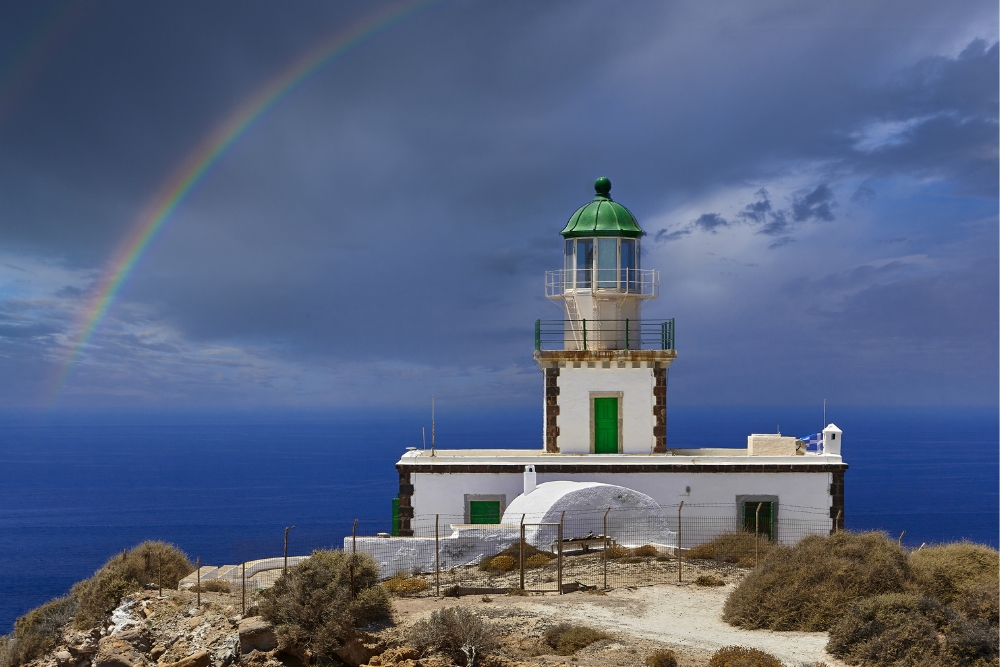
How Can Visitors Get to Akrotiri From the Main Town of Fira on Santorini?
To get to Akrotiri from Fira, hop on a bus or hire a taxi for a quick and convenient journey. Buses run regularly, providing an affordable and scenic route. Taxis offer a more private and direct option.
Are There Any Guided Tours Available for Exploring the Ancient Ruins of Akrotiri?
Yes, guided tours are available for exploring the ancient ruins of Akrotiri. These tours offer expert insights, context, and a deeper understanding of the site’s historical significance, enhancing your overall experience.
Can Visitors Climb to the Top of Any Structures at the Archaeological Site?
Yes, visitors can climb to the top of some structures at the archaeological site. The views are breathtaking from these vantage points and offer a unique perspective of the ancient ruins and the surrounding landscape.
Are There Any Restrictions on Photography Within the Ruins of Akrotiri?
Yes, you can take photos at Akrotiri, but some areas may have restrictions for preservation. Respect the signs and barriers. Capture the beauty and history, but remember to remember the ancient site’s sensitivity to light exposure.
What Are the Best Times of Day to Visit Akrotiri to Avoid Crowds and Make the Most of the Experience?
For the best experience at Akrotiri, aim to visit early mornings or late afternoons to avoid crowds and capture the beauty in quieter moments. The soft light during these times will enhance your exploration.
Final Thoughts On Exploring Akrotiri
As you journey through the ancient ruins of Akrotiri in Santorini, Greece, you will uncover a world shrouded in mystery and wonder. The intricate frescoes, urban planning insights, and archaeological discoveries offer a glimpse into a past civilization that thrived on this beautiful island. The significance of Akrotiri cannot be understated, as it provides a unique window into Santorini’s ancient past. Explore these ruins and immerse yourself in the history and culture of this captivating destination.
Photos: Canva Pro

